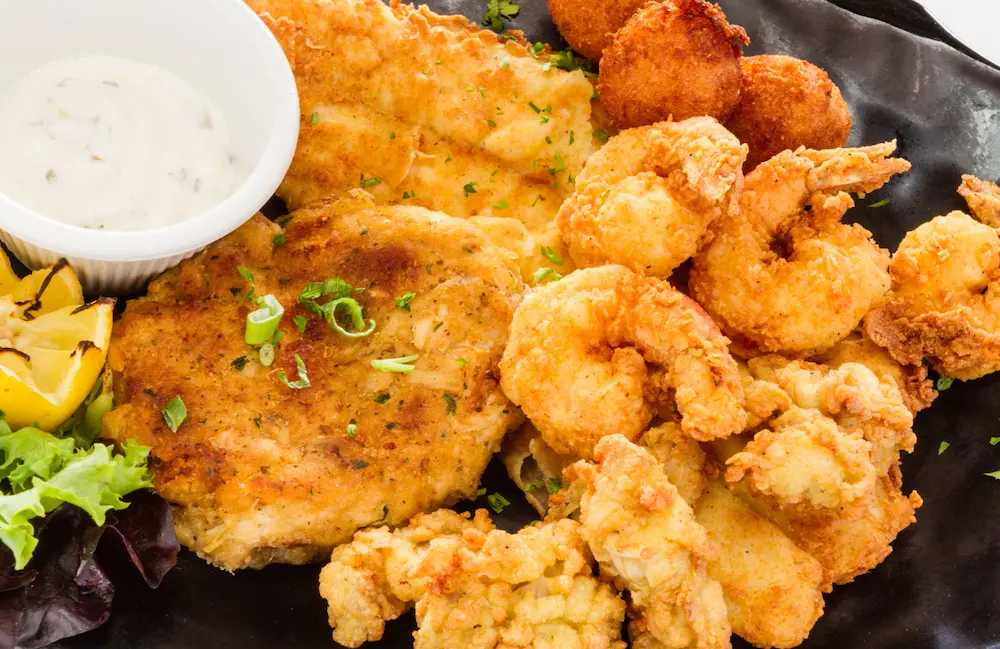If you have visited NC Seafood Restaurant for our Calabash-style seafood platters, you’ll know that our portions are extremely generous. With that said, you may have taken your leftovers home and want to reheat them for lunch or dinner. But what’s the best way to reheat seafood? Can you reheat battered and fried seafood without losing that delicious crunch?
The short answer is yes, but you need to take some care to ensure it comes out just as delicious as the first time around. Join NC Seafood Restaurant in Raleigh as we uncover top-tier tips for reheating our crispy Calabash-style seafood.
The Challenge with Reheating Seafood

Fresh, crispy seafood is one of life’s great treats. However, leftover seafood that has managed to get cold and soggy is better thrown away. So, how can you save your leftovers and ensure your leftovers achieve the level of crispiness you’re looking for? If you’re reheating lightly battered seafood, the delicate coating, such as that on our seafood, can quickly lose its crispy texture because there’s not much batter in the first place.
Additionally, you’ll want to ensure you don’t overcook your seafood when you reheat it. So, whether you’re looking to serve up reheated fresh or fried seafood, let’s talk about how to reheat seafood the proper way.
How to Reheat Seafood: The Proper Way
If you’re wondering how to reheat seafood the right way, then you’ve come to the right place! Let’s dive into the methods you should use to bring your seafood back up to par.
- Use a preheated oven
- Before reheating your seafood, it’s important to preheat your oven to the right temperature. This will help to ensure that the seafood cooks evenly and maintains its crispiness. A temperature of 350-375°F is ideal for reheating battered and fried seafood.
- Flip the food
- The length of time that you reheat a fried seafood dish can vary. An average cooking time is about 15 minutes. Flipping halfway through, or even every 5 minutes can ensure that all sides of your fried seafood get crispy.
- Use parchment paper
- To prevent the seafood from sticking to the baking sheet, line it with parchment paper. This will also help to absorb any excess oil and keep the seafood crispy.
- Don’t overcrowd!
- Make sure you don’t overcrowd the baking sheet, as overcrowding can cause seafood to become soggy. Make sure you give each piece of seafood enough room for steam to escape. If you have a lot of seafood to reheat, such as our combo plates, use a large baking sheet or reheat in batches.
- Don’t cover it!
- As we alluded to previously, it’s important for the steam to escape. So, don’t cover it with anything that would trap in steam and moisture and prevent it from getting crispy.
- Serve immediately!
- Don’t let it sit on the baking sheet too long. As soon as it’s done cooking, serve it and enjoy.
How do you reheat seafood without overcooking it?
- Use a thermometer
- If you have a meat thermometer, this would be a great time to use it. The most common seafood reheating mistake is overcooking. Check the internal temperature so that it is a minimum of 145 degrees Fahrenheit.
- Check it often
- Fried seafood can reheat quickly, so make sure you check it often. A regular cook time is about 15 minutes, but that depends on the type of seafood, its thickness, and desired temperature.
How to Reheat Seafood: Alternative Ways
- Use an air fryer to reheat seafood. Air fryers are the latest cooking gadget that is popular for a good reason – they cook food in a short amount of time using rapid air circulation to evenly distribute heat. In as little as 5 minutes, you can have your seafood reheated to perfection.
- Use low heat. The best way to reheat many types of seafood is in the oven at a low temperature. Bear in mind that different types of seafood have slightly different reheating requirements. For example, delicate fish like cod should be reheated gently for a shorter time than denser fish like swordfish or tuna. To prevent seafood from dying out, place it on a baking sheet with a splash of water or broth.
- Reheat seafood in a skillet. Did you know that you can reheat seafood on a skillet on the stovetop? While certain seafood should only be reheated in the oven, some seafood, like our spicy peel & eat shrimp or crab can be reheated quickly in a skillet. To keep the juicy flavors locked in, you can drizzle a little bit of olive oil or white wine into a skillet.
Visit NC Seafood Restaurant for Perfectly Crispy Seafood
Reheating battered and fried seafood can be a challenge, but with the right techniques, you can enjoy leftovers that are just as delicious as the original dish. Our tips will help you get the most out of your delicious leftovers without sacrificing flavor or texture.
To stay up to date on our seafood tips, vibrant recipes, and the latest happenings, be sure to subscribe to our monthly newsletter. We promise to only send you one newsletter a month so you’ll never be bombarded with our emails. Sign up below!
